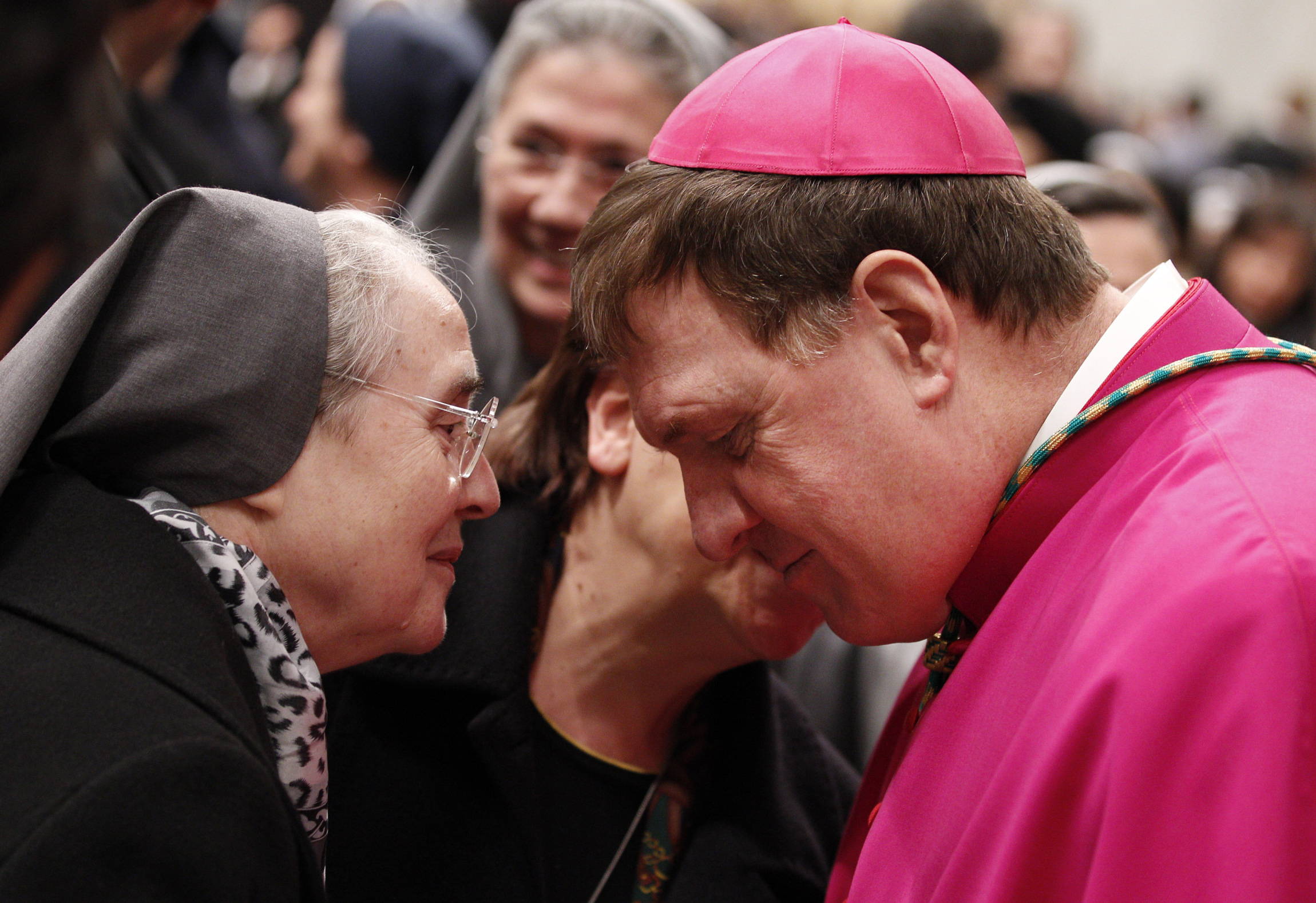
Archbishop Joseph W. Tobin talks with religious women after a vespers service at the Vatican in this Feb. 2 file photo. (CNS photo/Paul Haring)
The Vatican announced Thursday that Archbishop Joseph Tobin, secretary of the Congregation for the Institutes of Consecrated Life and Societies of Apostolic Life (more commonly known as the Congregation for Religious), will become the sixth archbishop of the Indianapolis archdiocese.
A Detroit native who was ordained a priest in 1978, Tobin is a Redemptorist and the former Superior General of his religious order, serving in Rome as its leader from 1997-2009.
After spending most of the past 15 years in the Vatican, the assignment back to the states will place Tobin, 60, as head of a diocese for the first time. He was named archbishop in August 2010 when he became the Congregation for Religious' No. 2 official.
The congregation oversees approximately 190,000 religious priests and brothers, and 750,000 religious sisters across the globe.
While brief, Tobin's two years with the congregation coincided with one of the more controversial investigations undertaken in recent years -- the apostolic visitation of U.S. women religious.
Authorized in December 2008 by the then-prefect for the Congregation for Religious, Slovenian Cardinal Franc Rodé, the visitation was originally described as a study of the community, prayer and apostolic life of women's orders; but a year into the study, Rodé revealed to Vatican Radio that concerns about a secular mentality and feminist spirit spurred the investigation.
Sisters, as well as Vatican observers, viewed Tobin's entrance at the visitation's midpoint as a positive development for the U.S. religious orders, bringing not only an American into the investigation but one with experience working with their congregations and one many viewed as a realist and a moderate.
"I feel I can bring something to that, because I've worked all my life with women's religious," Tobin told NCR a day after his appointment as the congregation's No. 2. "They taught me when I was a kid, and my mother's family was very close to the Immaculate Heart of Mary sisters.
"I've preached women's retreats and listened a lot to them over the years. Maybe I can offer a different picture of American women religious than the one that has been presented in Rome. My own impression is extremely positive," he said at the time.
Given his reputation as fair-minded and sister-friendly, Tobin acknowledged his appointment might have suggested "some awareness of just how badly this thing has gone down," adding he wanted to "bring life" from the apostolic visitation, and make it a positive experience.
"It was good news for us," Franciscan Sr. Marlene Weisenbeck, former president of the Leadership Conference of Women Religious told NCR in August 2010. "We felt very encouraged by it. Our visits with him felt like a brother and sisters meeting together. ... He knows the difficulties of church politics as much as he knows about the beauty of the church and its universality and its diversity."
The Congregation for Religious' visitation was separate from the investigation launched by the Congregation for the Doctrine of the Faith into LCWR, which represents about 80 percent of U.S. Catholic sisters.
The apostolic visitation included four phases, the first involving interviews between Mother Mary Clare Millea, the Vatican-appointed director of the three-year study, and major superiors of congregations, followed by a phase two questionnaire to almost 400 religious communities, many refusing to or only partially answering them.
In the third phase, visitation teams made on-site trips to about 90 communities, with Millea and her team compiling the collected data into a final report in the fourth phase.
Millea presented her findings to the Vatican in early January. To date, the Vatican has yet to respond or issue its own formal report on the visitation.
In December 2010, Tobin said Rome must acknowledge the anger expressed by sisters stemming from the visitation, and that he did not anticipate "punitive" fallout from the visitation.
"If the visitors, in dialogue with the sisters, have identified some specific issues that need to be dealt with, okay. But forcing people into habits or something like that? That's not what this is about," he told NCR in a Dec. 6, 2010, interview.
He added he would advocate for the sisters' right to reply and provide feedback before policy decisions are made, calling it a matter of "justice and charity."
In January 2011, Brazilian archbishop João Bráz de Aviz replaced Rodé as prefect and Tobin's superior.
As the investigation neared its completion, major superiors met with Millea in Chicago in April 2011 to discuss the experience, with some echoing the importance of Tobin, who had signaled he and Aviz wanted dialogue, not confrontation, entering the process.
"It's a whole different tone since Archbishop Tobin became [secretary] of the Congregation for Religious. Some communities have made the best of it," an attendee to the meeting told NCR.
Outside the apostolic visitation, as secretary of the congregation Tobin was part of the May 2011 decision to suppress the Cisterian abbey at the Basilica of the Holy Cross in Jerusalem.
He also oversaw the continuing progress on a document on the vocation to the religious brotherhood, in the works since 1985, and helped usher in a somewhat new practice of meeting with religious orders' headquarters in Rome outside official Vatican summonings.